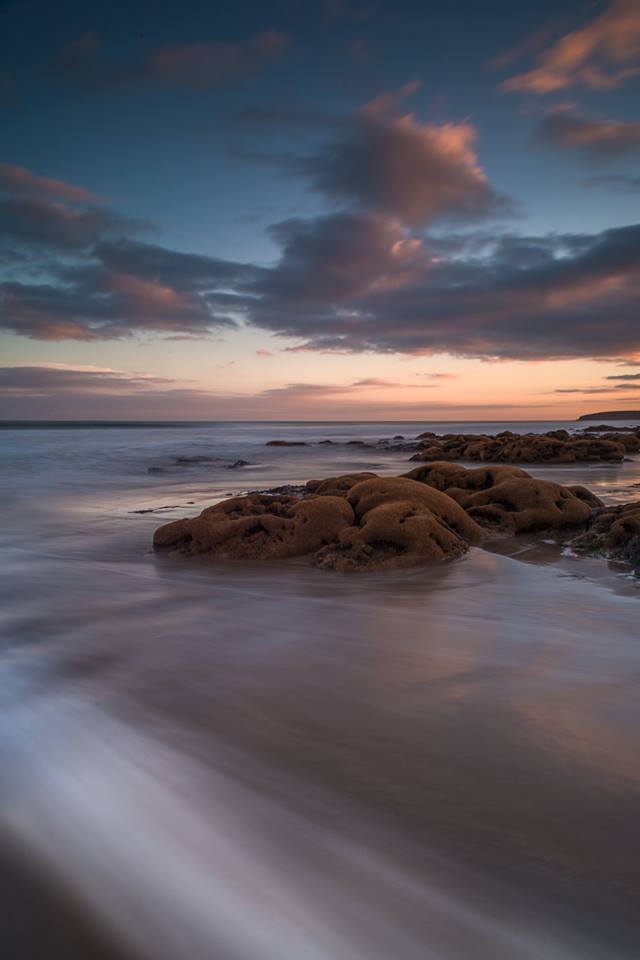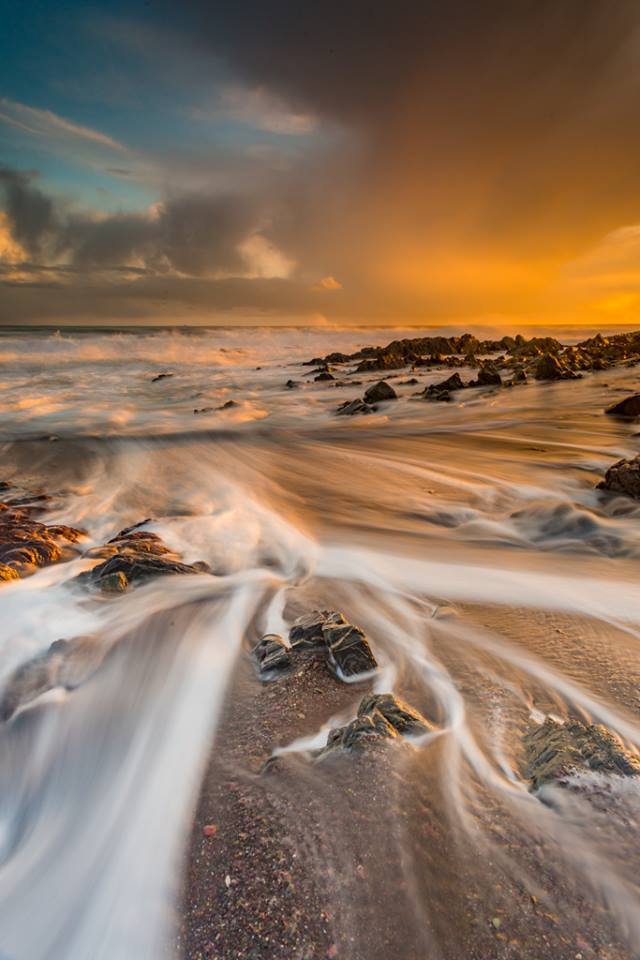The Geography of Ballybrannigan Strand
A geographical overview of beaches, with particular reference to Ballybrannigan beach, Co. Cork.
by Andrew Levis
Beaches are features of deposition found in coastal areas between high and low tide. They are generally found in areas where there is an inlet or sheltered area, between headlands or a change in the coastline, which causes sediment to be trapped and build up. If a beach is found in a bay, it is called a bay head beach.
Beaches are areas of sand, shingle and larger stones. The size of the material found on a beach varies from front to back. The area of a beach that is closest to the sea is known as the foreshore. The material found here is very small, containing sand particles and shingle. You may also find runnels and ridges here.
The back of the beach is known as the backshore, also known as a storm beach. The material found here is large, containing large rocks and boulders. These are deposited here during stormy weather, when powerful waves are created throwing up the large material on to the back of the beach. At the same time the erosive power of the waves (amongst other erosion processes such as attrition and abrasion) cause erosion to occur regularly during stormy weather. More on that shortly.
The final area of a beach The area of the beach in between the foreshore and backshore is known as the midshore. The material found here would be mainly pebbles and stones, not as small as the shingle material but not as large as the boulder material. You can also find ripple marks here, gentle lines in the sand created by the swash. Beach cusps may also be found here. These are crescent shaped hollows in the beach, where you tend to find the shingle changing into softer sand.
Earlier I referred to erosion. There are 4 main types of erosion active on a given coastline. The first one is abrasion; this is the load or material found within a wave that is thrown against the coastline. This is the most powerful erosion type and therefore it does most of the damage.
The second erosion type is known as attrition. This is the load found within a wave eroding itself. It results in very round pebbles being found o the shoreline, further proof that erosion is active in a given area.
The third erosion type is known as hydraulic action. This is the force of the water doing the eroding. It results in air compression being used as an explosive type of erosion, common in the formation of caves and arches. More on that later.
The final erosion type is solution. This is where acids found within the water react which minerals in the rock, slowly dissolving them. An example of this is carbonic acid reacting with calcium carbonate in limestone. Given that limestone is the most common rock in Ireland, this is a very prevalent form of erosion in this country.
There are also different types of waves, the first of which are known as destructive waves. This is where the backwash is more powerful than the swash, resulting in erosion being more active than deposition. This means only small, if any, beaches are formed.
The other type of waves are known as constructive waves. This is where the swash is stronger than the backwash, meaning more material is left deposited on the coastline and not removed by the backwash as it's weak, forming beaches.
Longshore drift is the movement of material from one side of a beach to another, in a zig-zag pattern. The waves approach the beach at an angle, but return perpendicular to the beach. This process repeats itself and the material is moved across the beach. It also results in a number of landforms being created.
In terms of features of erosion being formed on the coastline, these are the main ones:
- Cliffs - steep land found on a coastline
- Wave cut platforms - formed by collapsing cliffs as a result of undercutting
- Bays - formed where there is a band of less resistant rock surrounded by an area of more resistant rock
- Headlands - formed where there is an area of resistant rock with another section of less resistant rock found within it
- Caves - a hollow indentation into the coastline
- Arches - formed when two caves form either side of a headland and meet
- Stacks - collapsed arches
- Stumps - collapsed stacks
In terms of features of deposition being formed on the coastline, these are the main ones:
- Beaches - a pebbly or sandy shore formed between high and low water marks
- Spits - deposition bar formed by a build up of material off a coastline and by the process of longshore drift
- Bars - a ridge of sand or shingle which forms across the mouth of a river, the entrance to a bay or a harbour
- Tombolos - where an island is attached to the mainland by a narrow piece of land such as a spit or a bar
In terms of Ballybrannigan beach, this is located on the south coast of Ireland and lies directly in the path of both the Mid Atlantic Drift and the south-westerly wind (Ireland's prevailing wind). These two things result in erosion being very active along the coastline where Ballybrannigan beach can be found. Deposition is clearly active here, as there is a beach formed also.
In fact, such was the rate of erosion occurring here, that Cork County Council had to close the beach and address the erosion and its consequences as it has become too dangerous for people to go on to. The car park, the slipway and the strengthening of the cliff face were all part of the council's planned worked during its closure and it is now due to re-open very soon.
It was during a major storm in April 2016 where the vast majority of damage was caused to the area, resulting in its closure. The significance of the beach to the population of the surrounding area cannot be underestimated, with it having been the centerpiece of thousands of people's childhood and they then make it the centerpiece of their children's childhood.
As a result, its closure led to a large public outcry for its reopening and support for this snowballed through the wonder that is social media. It is a beach that is used by a number of organisations, individuals and dog walkers amongst others, so the reaction to its closure should not have come as a surprise. Local councilors such as Susan McCarthy and Michael Hegarty have echoed the repeated calls to have it reopened, as it is a significant loss to the local area as an amenity.
As for the geology of the region, there are two main rock types found in the area of Ballybrannigan beach. These are sandstone and limestone, however there are also deposits of shale to be found here also. Limestone is less resistant than sandstone, which means that there are a number of places along the south coast, of which Ballybrannigan is no different, where bays and headlands can be found.
The ridge and valley nature of
the Munster landscape, also plays a part in the geology and topography of the
land in question here too. With many anticlines and synclines located in the
area, this gives rise to many bands of rock bent and contorted into all sorts
of layers, formed during the Armorican and Caledonian folding periods, when
Ireland was closer to plate boundaries but has moved away since due to
continental drift.
The result of this is differing rock tops being found at
various places along the coastline and by extension, different features of
erosion and deposition being formed here too.


